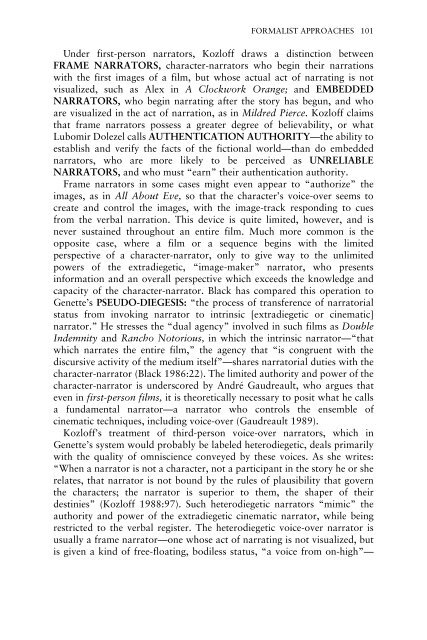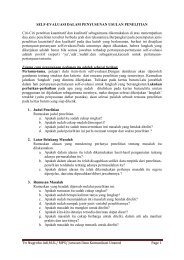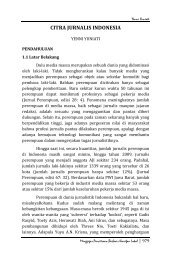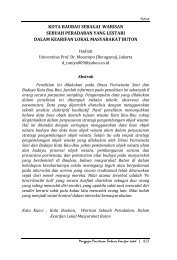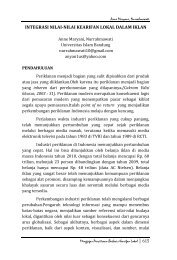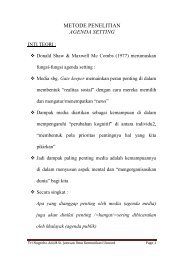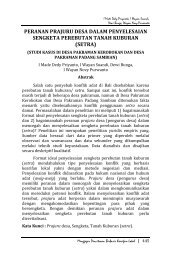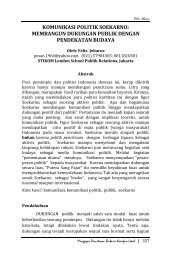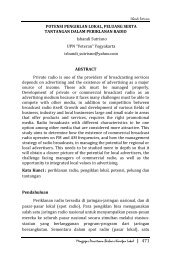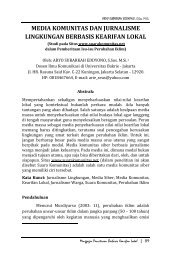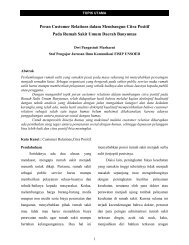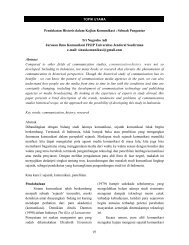New Vocabularies in Film Semiotics
New Vocabularies in Film Semiotics
New Vocabularies in Film Semiotics
Create successful ePaper yourself
Turn your PDF publications into a flip-book with our unique Google optimized e-Paper software.
FORMALIST APPROACHES 101<br />
Under first-person narrators, Kozloff draws a dist<strong>in</strong>ction between<br />
FRAME NARRATORS, character-narrators who beg<strong>in</strong> their narrations<br />
with the first images of a film, but whose actual act of narrat<strong>in</strong>g is not<br />
visualized, such as Alex <strong>in</strong> A Clockwork Orange; and EMBEDDED<br />
NARRATORS, who beg<strong>in</strong> narrat<strong>in</strong>g after the story has begun, and who<br />
are visualized <strong>in</strong> the act of narration, as <strong>in</strong> Mildred Pierce. Kozloff claims<br />
that frame narrators possess a greater degree of believability, or what<br />
Lubomir Dolezel calls AUTHENTICATION AUTHORITY—the ability to<br />
establish and verify the facts of the fictional world—than do embedded<br />
narrators, who are more likely to be perceived as UNRELIABLE<br />
NARRATORS, and who must “earn” their authentication authority.<br />
Frame narrators <strong>in</strong> some cases might even appear to “authorize” the<br />
images, as <strong>in</strong> All About Eve, so that the character’s voice-over seems to<br />
create and control the images, with the image-track respond<strong>in</strong>g to cues<br />
from the verbal narration. This device is quite limited, however, and is<br />
never susta<strong>in</strong>ed throughout an entire film. Much more common is the<br />
opposite case, where a film or a sequence beg<strong>in</strong>s with the limited<br />
perspective of a character-narrator, only to give way to the unlimited<br />
powers of the extradiegetic, “image-maker” narrator, who presents<br />
<strong>in</strong>formation and an overall perspective which exceeds the knowledge and<br />
capacity of the character-narrator. Black has compared this operation to<br />
Genette’s PSEUDO-DIEGESIS: “the process of transference of narratorial<br />
status from <strong>in</strong>vok<strong>in</strong>g narrator to <strong>in</strong>tr<strong>in</strong>sic [extradiegetic or c<strong>in</strong>ematic]<br />
narrator.” He stresses the “dual agency” <strong>in</strong>volved <strong>in</strong> such films as Double<br />
Indemnity and Rancho Notorious, <strong>in</strong> which the <strong>in</strong>tr<strong>in</strong>sic narrator—“that<br />
which narrates the entire film,” the agency that “is congruent with the<br />
discursive activity of the medium itself”—shares narratorial duties with the<br />
character-narrator (Black 1986:22). The limited authority and power of the<br />
character-narrator is underscored by André Gaudreault, who argues that<br />
even <strong>in</strong> first-person films, it is theoretically necessary to posit what he calls<br />
a fundamental narrator—a narrator who controls the ensemble of<br />
c<strong>in</strong>ematic techniques, <strong>in</strong>clud<strong>in</strong>g voice-over (Gaudreault 1989).<br />
Kozloff’s treatment of third-person voice-over narrators, which <strong>in</strong><br />
Genette’s system would probably be labeled heterodiegetic, deals primarily<br />
with the quality of omniscience conveyed by these voices. As she writes:<br />
“When a narrator is not a character, not a participant <strong>in</strong> the story he or she<br />
relates, that narrator is not bound by the rules of plausibility that govern<br />
the characters; the narrator is superior to them, the shaper of their<br />
dest<strong>in</strong>ies” (Kozloff 1988:97). Such heterodiegetic narrators “mimic” the<br />
authority and power of the extradiegetic c<strong>in</strong>ematic narrator, while be<strong>in</strong>g<br />
restricted to the verbal register. The heterodiegetic voice-over narrator is<br />
usually a frame narrator—one whose act of narrat<strong>in</strong>g is not visualized, but<br />
is given a k<strong>in</strong>d of free-float<strong>in</strong>g, bodiless status, “a voice from on-high”—


